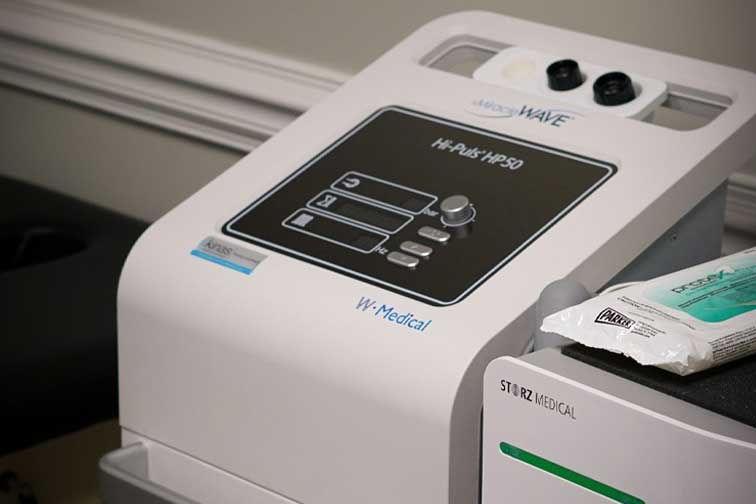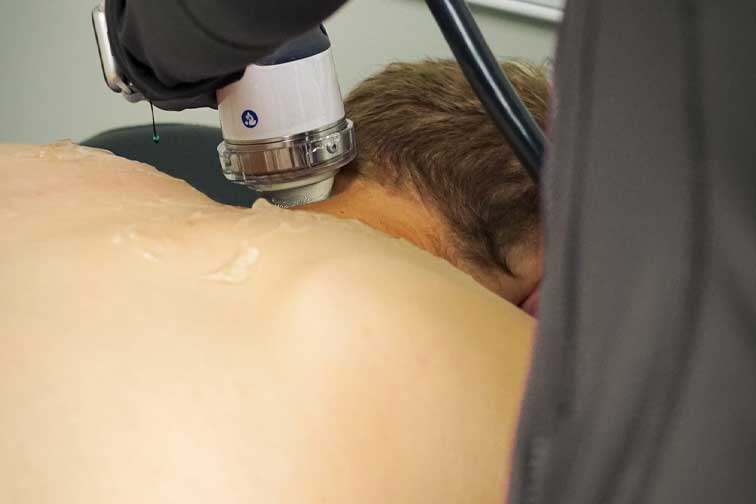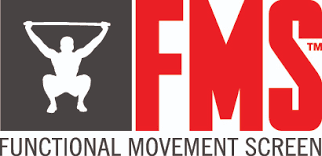Welcome to our detailed guide on shockwave therapy, an exciting treatment available at our Burlington chiropractic clinic. This non-invasive therapy has proven effective in treating various painful conditions related to muscles and joints. Here, we’ll explain what shockwave therapy is, how it works, what conditions it can help with, and what you can expect during a session.

What is Shockwave Therapy?
Shockwave therapy, also called extracorporeal shockwave therapy (ESWT), is a treatment that uses sound waves to help heal and reduce pain in damaged tissues. Originally designed to break up kidney stones, this treatment is now used to address many musculoskeletal issues commonly faced by athletes and the general population. The therapy involves sending high-energy sound waves to the problem area to stimulate your body’s natural healing processes.
How Does Shockwave Therapy Work?
Shockwave therapy helps your body heal in several ways:
1. Improved Blood Flow: The sound waves increase blood circulation in the treated area, bringing more nutrients and oxygen to the tissues and helping remove waste products. This speeds up the healing process.
2. Collagen Production: Shockwave therapy boosts the production of collagen, a protein that strengthens and repairs tissues such as tendons and ligaments.
3. Breakdown of Calcifications: The therapy breaks down calcium deposits in soft tissues, which can cause chronic pain. Once broken down, the body can absorb these particles, reducing pain and improving function.
4. Reduced Pain Signals: Shockwave therapy lowers the levels of Substance P, a chemical in the body associated with pain and inflammation, leading to pain relief and less inflammation.
5. Cellular Repair: The therapy encourages the release of growth factors that help repair and regenerate damaged cells, promoting faster healing.

Conditions Treated by Shockwave Therapy
Shockwave therapy can treat many conditions, especially those involving chronic pain and tendon problems. Common conditions include:
1. Plantar Fasciitis: Plantar Fasciitis involves inflammation of the tissue along the bottom of the foot. Shockwave therapy can reduce pain and inflammation, helping the tissue heal.
2. Tendinitis: Whether it’s Achilles tendinitis, jumper’s knee, or rotator cuff tendinitis, shockwave therapy can reduce pain and speed up recovery for tendon injuries.
3. Tennis Elbow and Golfer’s Elbow: These conditions cause pain and inflammation in the elbow tendons. Shockwave therapy can help relieve pain and restore function.
4. Calcific Tendonitis: This condition involves calcium deposits in the tendons, causing pain. Shockwave therapy breaks down these deposits and promotes healing.
5. Shoulder Pain: Conditions like shoulder impingement and frozen shoulder can benefit from shockwave therapy, which helps reduce pain and improve movement.
6. Hip Pain: Conditions like greater trochanteric pain syndrome and other hip-related issues can be managed with shockwave therapy.
7. Chronic Muscle Pain: Conditions like myofascial pain syndrome, which involves chronic muscle pain, can be relieved with this therapy.
What to Expect During a Shockwave Therapy Session
If you’re considering shockwave therapy, here’s what typically happens during a session:
1. Initial Consultation: The first session starts with a consultation where the chiropractor reviews your medical history, examines you, and discusses your symptoms to see if shockwave therapy is right for you.
2. Preparation: The treatment area is cleaned, and a special gel is applied to help transmit the sound waves through your skin to the tissues.
3. Applying the Shockwaves: The chiropractor uses a handheld device to deliver the shockwaves to the problem area. You might feel a tapping or pulsing sensation, which can be slightly uncomfortable but not painful.
4. Session Duration: Each session lasts about 15 to 20 minutes, depending on the condition and size of the area being treated. Most people need three to five sessions to see significant improvement.
5. Aftercare: After the session, you might have some redness or swelling in the treated area, but this usually goes away within a few hours. The chiropractor may give you exercises or activities to help with recovery.
6. Follow-Up: You’ll have follow-up sessions based on your progress. The chiropractor will monitor your improvement and adjust the treatment plan as needed.
Benefits of Shockwave Therapy
Shockwave therapy offers many benefits, making it a great option for non-invasive treatment:
1. Non-Surgical: It’s a non-invasive alternative to surgery, avoiding the risks and recovery time associated with surgical procedures.
2. Quick Recovery: You can return to your regular activities shortly after treatment, with minimal downtime.
3. High Success Rate: Studies show a high success rate for shockwave therapy in treating various musculoskeletal conditions, often with 70-80% improvement.
4. Minimal Side Effects: Side effects are rare and usually mild, such as temporary redness, swelling, or bruising.
5. Pain Relief: Many patients experience significant pain relief after just a few sessions, improving their quality of life and daily activities.
Shockwave Therapy vs. Laser Therapy
While both shockwave therapy and laser therapy are non-invasive treatments used to promote healing and reduce pain, they work in different ways and are suitable for different conditions. Shockwave therapy uses acoustic waves to stimulate healing and break down calcium deposits, making it particularly effective for chronic tendon issues and calcific tendinitis.
Laser therapy, on the other hand, uses light energy to penetrate tissues and promote cellular repair, often used for inflammation, soft tissue injuries, and wound healing. Both treatments have their own set of advantages, and our sports chiropractors can help determine which therapy is best suited for your specific condition.
Is Shockwave Therapy Right for You?
While shockwave therapy is effective for many people, it might not be suitable for everyone. Conditions like infections, tumors, or certain circulatory disorders might prevent you from using this therapy. It’s important to consult with a qualified healthcare professional to see if shockwave therapy is the right choice for you.
Conclusion
Shockwave therapy is a major advancement in sports chiropractic care. By using sound waves, this treatment promotes healing, reduces pain, and improves function for many musculoskeletal conditions. If you’re dealing with chronic pain or a persistent injury, shockwave therapy might be the solution you need. Contact our Burlington clinic today to schedule a consultation and find out how shockwave therapy can help you achieve better health and wellness.


